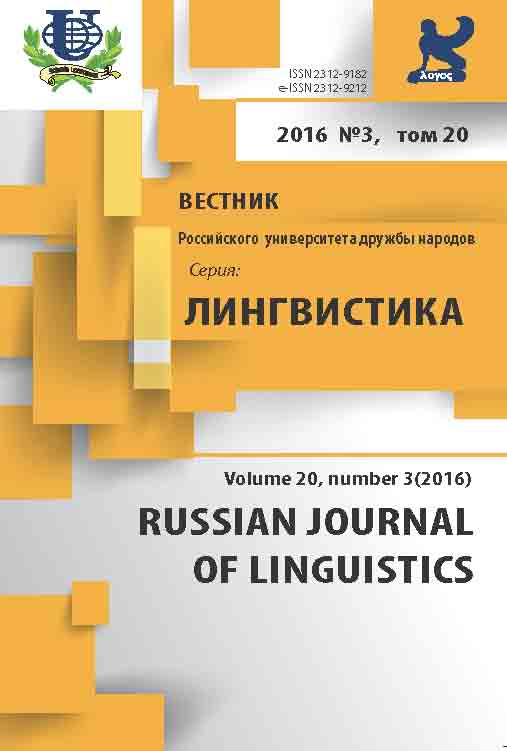Intertextuality: Ariadne’s Thread in the Exploration of Literature
- Authors: Turaeva Z.Y.1
-
Affiliations:
- Independent scholar
- Issue: Vol 20, No 3 (2016)
- Pages: 31-42
- Section: Articles
- URL: https://journals.rudn.ru/linguistics/article/view/14738
- ID: 14738
Cite item
Full Text
Abstract
This essay is devoted to the phenomenon of intertextuality as an essential aspect of text generation and analysis. Following Mikhail Bakhtin’s theory of the dialogic nature of the text and culture, it deals with such aspects of the text as polyfunctionality, polysemy and anthropocentricity. It seeks to show that the text combines three functions: cognitive, communicative and aesthetic and focuses on quotations and allusions as omnipresent elements of literary texts. Applying text and genre analysis, I explore intertextual links in poetic and prosaic pieces by Russian, British and American authors. In these analyses intertextuality emerges as a way to connect times and experiences and stimulate creative thinking. They also illustrate that a literary text is distinguished by two seemingly contradictory tendencies: stability and constant innovation. It is the symbiosis of the two that stimulates the preservation of the old and generation of new knowledge.
Keywords
About the authors
Zinaida Yakovlevna Turaeva
Independent scholar
Email: zinaida.turaeva@mail.ru
14, Furtwanger Str., 71034, Boeblingen, Deutschland
References
- Адмони В.Г. и Сильман Т.И. Структура художественного текста и перевод. М.: Союз Писателей, 1967. [Admoni, V.G. & Sil’man (1967). Struktura khudojestvennogo texta i perevod [Literary Text Structure and Translation]. Moscow: Soyuz Pisatelei (In Russian).]
- Aтлас А.З. О внетекстовых семантических связях поэтического текста. Семантика и прагматика единиц языка в тексте. Л., 1988. [Atlas, A.Z. (1988). O vneteksovikh svyaziah poeticheskogo texta. Semantika i pragmatika edinits v texte [Non-textual links of Poetic Text. Semantics and Pragmatics of Text Units], Lenigrad (In Russian).]
- Бахтин М. Автор и герой. К философским основам гуманитарных наук. СПб, 2000. [Bakhtin, M. (2000). Avtor i geroi. K pholosophskim osnovam gumanitarnih nauk [Author and Hero. Regarding Philosophical Basis of Humanities]. SPb. (In Russian).]
- Бондарко А.В. Грамматическое значение и смысл. Л.: Наука, 1978. [Bondarko, A.V. (1978). Grammaticheskoe znachenie i smysl [Grammatical Meaning and Sense]. Leningrad: Nauka (In Russian).]
- Гальперин И.Р. Текст как объект лингвистического исследования. 7-е изд. Серия Лингвистическое наследие ХХ века. М.: ЛИБРОКОМ, 2009. [Gal’perin, I.R. (2009). Text kak ob’ekt lingvisticheskogo issledovanija (7th ed.) [Text as Linguistic Research Subject]. Seria Lingvisticheskoe nasledie XX veka. Moscow: LIBROKOM (In Russian).]
- Гоголь Н.В. Театральный разъезд после представления новой комедии. М.: Государственное издательство художественной литературы. 1948. [Gogol, N.V. (1948). Leaving the Theater after the Performance of a New Comedy. Moscow: Gosydarstvennoe izdatel’stvo khudojestvennoy literaturi (In Russian).]
- Кристева Ю. Семиотика. Исследования по семанализу. М.: Академический Проект. 2013. [Kristeva, Yu. (2013). Semiotika. Issledovanija po samoanalizu [Semiotics. Self-analysis Studies]. Moscow: Akademicheskiji Proekt (In Russian).]
- Лунькова Л.Н. Проблема интертекстуальности в рамках лингвистического анализа художественного текста // Вестник РУДН. Серия: Лингвистика. 2008. № 4. C. 90-95. [Lun’kova, L.N. (2008). Problema intertextualnosti v ramkah lingvisticheskogo analisa [Intertextuality within Linguistic Analysis]. Russian Journal of Linguistics, N. 4, 90-95 (In Russian).]
- Москальская О.И. Проблемы системного описания синтаксиса. М.: Наука, 1974. [Moskal’skaya, O.I. (1974). Problemy sistemnogo opisania syntaksisa [Problems of Syntaxes System Description]. Moscow: Nauka (In Russian).]
- Реферовкая Е.А. Лингвистические исследования структуры текста. М.: Наука. 1983. [Referovskaya, E.A. (1983). Lingvisticheskie issledovanija strukturi texta [Linguistic Studies of Text Structure]. Moscow: Nauka (In Russian).]
- Тураева З.Я. Текст структура и семантика. Издание второе, дополненное. М.: URSS, 2009. [Turaeva, Z.Ya. (2009). Text struktura i semantika (2d ed.) [Text Structure and Semantics]. Moscow: URSS (In Russian).]
- Тураева З.Я. От мастерства писателя к открытиям читателя: В поисках сущности текста. М.: URSS, 2016. [Turaeva, Z.Ya. (2016). Ot masterstva pisat’lia k otkritiam chitatelia: V poiskakh sushnosti texta [From the Writer's Skill to the Reader's Discoveries. In Search of the Essence of a Text]. Moscow: URSS (In Russian).]
- Цивьян Т.В. Структура текста. М.: Наука, 1980. [Tzivian, T.V. (1980). Sruktura texta [Text Structure]. Moscow: Nauka (In Russian).]
- Abrams, M.H. (2009). A glossary of literary terms (9th ed.). Boston, MA: Wadsworth Cengage Learning
- Bakhtin, M. (2016, March 25) François Rabelais, Middle-aged Culture and Renaissance. Retrieved from: www.opentextnn.ru/man/?id=5400
- Bakhtin, M. (2016, March 3) Rabelais and Gogol. The Art of Writing and Folk Culture of Laugh. Retrieved from: www.gumer.info/bibliotek_Buks/Literat/bahtin/rabl_gog.php
- Barthes, R. (1974). The pleasure of the text. In R. Miller. Hill & Wang (transl.). New York: Farrar, Straus and Giroux, Inc. 1974
- De Beaugrande, R & Dressler, W.U. (1988). Introduction to Text Linguistics. London: Longman
- Donne, J. (2016, February 21). Meditation. Devotions upon Emergent Occasions. Retrieved from: www.famousliteraryworks.com/donne_for_whom_the_bell_tolls.htm
- Eliot, T.S. (2016, March 15). Marina. Retrieved from: www.youtube.com/watch?v=GtvORTmwcPc
- Enkvist, N.E. (1984). Contrastive Linguistics and Text Linguistics. In J. Fisiak (Ed.), Contrastive linguistics: Prospects and problems (pp. 45-68). Berlin, New York: Mouton Publishers
- Ferlinghetti, L. (2004). Poetry as Insurgent Art. Toronto: Penguin Books
- Ferlinghetti, L. (2016, February 15). The End of Various Affairs. Retrieved from: www.poemhunter.com/ lawrence-ferlinghetti/poems
- Halliday, M.A.K. (1975). Language as Social Semiotic. In J. Maibin (Ed.), Language and Literacy. Clevedon: Open University
- Milton, J. (2007). Paradise Lost. Introductory Note by C.W. Eliot. Raleigh, North Carolina: Hayes Barton Press
- Morson, G.S., Emerson C. & Bakhtin, M. (1990). Creation of a Prosaics. Stanford: Stanford University Press
- Shaw, I. (1996). Evening in Byzantium. New York: Integrated Media
- Todorov, T. (1982). Symbolism and Interpretation. In C. Porter (transl.). Ithaka, New York: Cornell University Press
- Warren, R.P. (2002). All the King’s Men (Restored ed.). San Diego, New York and London: Harcourt Inc
- Yeats, W.B. (2016, March 12) Sailing to Byzantium. Retrieved from: www.poemhunter.com/ poem/sailing-to-byzantium
- Yelenevskaya, M.N. (2000). The comfort of familiar words: Allusions in the Russian-language press in Israel. In A. Pavlovskaya (ed.) Russia and the West: A dialogue of cultures (pp. 242-253) V. 2
- van Dijk, T.A. (1972). Some aspects of text grammars: A study in theoretical linguistics and poetics. The Hague, Paris: Mouton
Supplementary files















